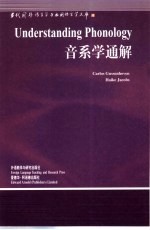图书介绍
音系学通解 英文版pdf电子书版本下载

- (英)CarlosGussenhoven,(英)HaikeJacobs著李兵导读 著
- 出版社: 北京:外语教学与研究出版社
- ISBN:7560023754
- 出版时间:2000
- 标注页数:295页
- 文件大小:13MB
- 文件页数:339页
- 主题词:
PDF下载
下载说明
音系学通解 英文版PDF格式电子书版下载
下载的文件为RAR压缩包。需要使用解压软件进行解压得到PDF格式图书。建议使用BT下载工具Free Download Manager进行下载,简称FDM(免费,没有广告,支持多平台)。本站资源全部打包为BT种子。所以需要使用专业的BT下载软件进行下载。如 BitComet qBittorrent uTorrent等BT下载工具。迅雷目前由于本站不是热门资源。不推荐使用!后期资源热门了。安装了迅雷也可以迅雷进行下载!
(文件页数 要大于 标注页数,上中下等多册电子书除外)
注意:本站所有压缩包均有解压码: 点击下载压缩包解压工具
图书目录
1 The production of speech 1
1.1 Introduction 1
1.2 The lungs and the larynx 2
1.2.1 The vocal cords:the open and vibrating glottis 3
1.2.2 Devoicing and aspiration 4
1.2.3 Special types of phonation 4
1.2.4 Pitch 5
1.3 The vocal tract 6
1.2.5 The glottal stop 6
1.3.1 The pharynx 7
1.4 Vowels 8
1.3.3 The mouth 8
1.3.2 The nasal cavity 8
1.5 Constrictions 10
1.5.1 Places of articulation 10
1.5.2 Types of constriction 11
1.6 Segmental duration 13
Preface by Halliday 13
王宗炎序 14
1.7 Complex consonants 15
1.7.2 Double articulations 15
1.7.1 Secondary articulations 15
1.7.3 Manner-contour consonants 16
1.8 Nonpulmonic consonants 16
Preface by Chomsky 17
1.9 Stress 17
1.10 Conclusion 17
2 Some typology:sameness and difference 19
2.1 Introduction 19
2.2 Morphosyntactic structure 19
2.2.1 Morphological structure 19
2.2.2 Syntactic structure 20
2.3 A world without phonological structure 22
沈家煊序 24
2.3.1 One phonology for all languages? 24
2.3.2 Two kinds of structure 25
2.4 There s a difference 27
Prefacep 27
2.5 Universals and implicational relations 29
2.5.1 Plain or special? 31
2.5.2 Avoiding complexity 32
2.5.3 A word of caution 33
2.5.4 System gaps 33
2.6 The aims of phonology 35
2.7 Conclusion 36
3 Making the form fit 38
3.1 Introduction 38
3.2 Hawaiian 39
3.3.1 The process of nativization 40
3.3 Adjustment processes 40
3.3.2 Adjustments in the native vocabulary 44
导读 45
3.4 Two approaches 45
3.4.1 Rules 45
3.4.2 Constraints 46
3.5 Choosing between rules and constraints 50
3.5.1 Gradient violation and unranked constraints 52
3.6 Conclusion 53
4 Underlying and surface representations 54
4.1 Introduction 54
4.2 Allophonic variation 54
4.3 Two levels of representation 57
4.4 Neutralization 60
4.5 Choosing the underlying form 61
4.6 Conclusion 62
5 Distinctive features 64
5.1 Introduction 64
5.2 Motivating distinctive features 64
5.3 Feature values 66
5.4 A set of distinctive features 67
5.4.1 Major-class features 67
5.4.2 Laryngeal features 70
5.4.3 Manner features 71
5.4.4 Ambiguity and nonspecification 72
5.5 Place features 74
5.6 Some examples 77
5.7 Redundant vs.contrastive features 80
5.8 Conclusion 84
6 Ordered rules 86
6.1 Introduction 86
6.2 SPE representations 86
6.3 SPE rules 88
6.3.1 Reference to the syllable 89
6.3.2 The brace 89
6.3.3 Variable feature values 90
6.3.4 Parentheses 91
6.3.5 The transformational rule format 91
6.4 Linear order 92
6.5 Extrinsic and intrinsic ordering 95
6.6 Feeding,counterfeeding,bleeding,counterbleeding 97
6.6.1 Feeding order 98
6.6.2 Counterfeeding order 98
6.6.3 Bleeding order 99
6.6.4 Counterbleeding order 99
6.7 Conclusion 102
7 A case study:the diminutive suffix in Dutch 104
7.1 Introduction 104
7.2 General Dutch rules 104
7.2.1 Final devoicing 104
7.2.2 Palatalization 105
7.3 Standard Dutch 106
7.2.3 Degemination 106
7.4 The dialect of Sittard 109
7.5 Conclusion 114
8 Levels of representation 116
8.1 Introduction 116
8.2 Defining an intermediate level of representation 116
8.3 Lexical Phonology 119
8.3.1 Reference to morphological labels 120
8.3.2 Exceptions 120
8.3.3 Structure preservation 121
8.3.4 Native-speaker intuitions 122
8.3.5 Application across word boundaries 122
8.4 Phonological information in the lexicon 123
8.3.6 Lexical rules apply before postlexical rules 123
8.5 Controversial properties of lexical rules 126
8.6 Beyond the surface representation 128
8.6.1 Phonetic implementation 128
8.6.2 Models of implementation 129
8.6.3 Deciding between phonology and phonetic implementationp 131
8.7 Conclusion 133
9 Representing tone 135
9.1 Introduction 135
9.2 The inadequacy of a linear model 136
9.3 Word-based tone patterns 137
9.3.1 Language-specific associations 139
9.4 Stability 141
9.5 Postlexical tone 142
9.6 The Obligatory Contour Principle 142
9.6.1 Violating the OCP 144
9.7 Conclusion 147
10 Between the Segment and the Syllable 149
10.1 Introduction 149
10.2 A skeletal tier 150
10.3 Syllabification:the Maximum Onset Principle 151
10.3.1 The sonority profile 152
10.4 Arguments for the CV tier 153
10.4.1 The templatic use of the CV tier 153
10.4.2 Unfilled and unassociated slots 156
10.4.3 Compensatory lengthening 158
10.5 Moras 160
10.6 Syllable-based generalizations 165
10.7 Post-MOP syllabification rules 166
10.7.1 Ambisyllabicity in English 167
10.8 Conclusion 171
11 Feature geometry 172
11.1 Introduction 172
11.2 Two Properties of assimilations 172
11.3 Natural feature classes 174
11.4 Building a tree 175
11.4.1 The place node 175
11.4.2 The laryngeal node 176
11.4.3 The supralaryngeal node 178
11.5 Spreading and delinking 180
11.5.1 Writing rules 181
11.6 Implications of underspecification 183
11.6.1 Default rules 183
11.7 Conclusion 186
12 Exploiting the feature tree 187
12.1 Introduction 187
12.2 Long-distance assimilation 187
12.2.1 Vowel harmony 191
12.3 Complex segments 194
12.3.1 Evidence for complex segments 197
12.3.2 The representation of palatals and palatoalveolars 199
12.3.3 Distinguishing among palatoalveolars 202
12.4 Conclusion 204
13 Stress and feet 206
13.1 Introduction 206
13.2 The phonological nature of stress 206
13.2.1 Metrical feet and feet in poetry 207
13.3 Stress as an absolute property of segments:linear phonology 209
13.4 Stress as relative prominence:nonlinear phonology 212
13.4.1 A parametric theory of relative prominence 212
13.4.2 Four types of bounded stress system 214
13.5 Conclusion 220
14.1 Introduction 221
14.2 Iambic and trochaic rhythm 221
14 Further constraining stress 221
14.3 Foot-based rules 227
14.3.1 Quantitative adjustments 227
14.3.2 Foot-based segmental rules 228
14.4 Stress and morphology 231
14.5 Stress and Optimality Theory 233
14.5.1 Constraining stress 234
14.6 Conclusion 238
15 Phonology above the word 239
15.1 Introduction 239
15.2 The case for prosodic constituency 239
15.2.2 The intonational phrase 243
15.2.1 The phonological utterance 243
15.2.3 The phonological phrase 245
15.2.4 The phonological word 247
15.3 Deriving prosodic constituents 249
15.3.1 Clitics 250
15.3.2 The syntactic residue 252
15.4 Prosodic constituency below the phonological word 254
15.5 Conclusion 255
Epilogue 256
Key to questions 258
References 265
Language index 277
Subject index 283
文库索引 287